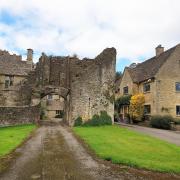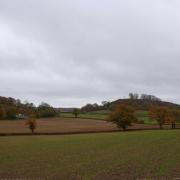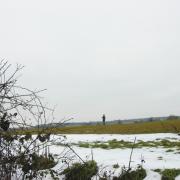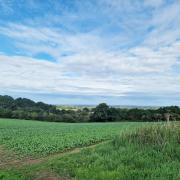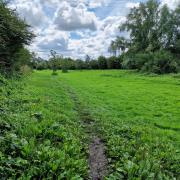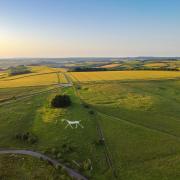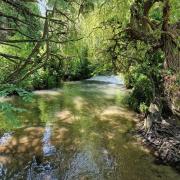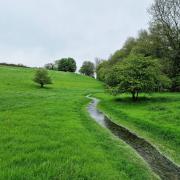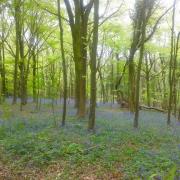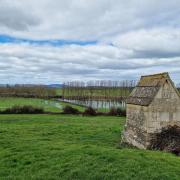A stroll in the heart of Gloucester to investigate some of the city’s ghostly denizens – dating from its medieval past to the halcyon days of its docks.
Gloucester docks today are busy with pleasure boats and shoppers. The warehouses you can see there are now flats. But let us go back to the bustling docks of the 1890s, when tall ships sailed up the Gloucester and Sharpness Canal to transfer their loads on to the boats that plied the River Severn. In the day, the place would be alive with the shouts of men, the clank of chains, the hiss of steam engines. At night, there would be shouts of a different nature, since the docks had many pubs. The nearest old pub that remains, in sight of Victoria Basin, is the Tall Ship. Note the little weighbridge toll house opposite where once wagons would have their weight checked before they entered the docks. Voices from many nations could be heard on those nights a century ago, voices raised in laughter, in song – and in anger.

From the Tall Ship, make your way down past the little Mariner’s Chapel to Reynolds Warehouse, which gives you a clear view across the Main Basin. If you’d been there one particular night in the 1890s, you’d have heard Spanish voices raised in anger. A barque from Spain was moored on what was Reynolds Quay, full of onions to be hawked to British kitchens. You’d have heard too the sound of punches being thrown, and grunts of pain. You wouldn’t have seen anything, though, for the fog lay heavy on the water. And fights like that? They were commonplace.
Make your way round the Barge Arm, past the Gloucester Waterways Museum and on to Llanthony Road, and head for the swing bridge. After crossing the bridge, turn right, past Gloucester Brewery and back down into the docks. Here you can today see tall ships like a barque – a three-or-more-masted ship with broad, square sails – awaiting treatment in the dry dock. But if you’d been on the docks the morning after that fight on Reynolds Quay a terrible sight would have met your eyes. As the mist faded away, the Spanish ship was revealed, and, instead of a sail, two sailors hung by their feet from the yardarm across the bow mast, their throats cut and their blood dripping on the deck below.

Cross over the walkway through the dry dock and make your way to the lock at the far end of the Main Basin. This is where the canal ends and the river begins. It was here, in the 1950s, that Harry the lock-keeper, emerging from his white lock-keeper’s house – visible on your left – to have a puff of his morning pipe, saw something uncanny. In the morning mist he could just make out the tall shapes of the warehouses. A crane loomed in the foreground, but beyond, in the basin, he saw a tall ship. You didn’t see many of those in the 1950s. As Harry stood there contemplating it the mist began to lift. He saw that from the yardarm hung the bodies of two men. The pipe fell from his lips. In the next blink of his eyes the ship was gone and the sunlight was shining on the tranquil water of the basin. Harry knew he’d seen the ghost of the Spanish ship, and some say that on misty mornings it can sometimes still be seen.

Turn right out of the docks along Commercial Road and cross to the snicket past Gloucester Prison, said to be one of the most haunted in the country. You come out by the octagonal Crown Court, built by French prisoners in the Napoleonic Wars. Head on towards the medieval heart of Gloucester – St. Peter’s cathedral. Instead of going directly to the cathedral, turn left on Westgate Street past the fine half-timbered building now housing the Folk at Gloucester. It bears a sign saying that it was ‘Bishop Hooper’s Lodging’. In fact, Bishop John Hooper spent but one night there. He was executed the following day, convicted of promulgating Protestant views during the reign of Queen Mary.


Cross the road and head through the little modern court on your right to emerge on Archdeacon Street. Ahead you can see the last remains of St Oswald’s Priory. Closer to hand is a small church, St Mary de Lode. Walk around the church and you’ll see the large Victorian monument to Hooper, who was burnt at the stake on this spot on 9 February 1555. It’s said that on dark nights in late winter you can see the face of Queen Mary in the window of the cathedral gatehouse opposite.
St Mary’s is the setting of an older, more heart-warming, and definitely more seasonal ghost tale. It’s said that on Christmas morning a hooded figure appears at the back of the church, causing the congregation to shiver and in full view of the presiding vicar. This ghost dates back to the 14th century, when the larger church next door was an abbey, not a cathedral. St Mary’s parish priest was so fired up with a desire to see the Bible translated into English that he travelled to Rome to plead with the Pope to let this happen. He told his parishioners he’d be back by Christmas Day. The day drew near and he still hadn’t returned. His parishioners kept faith and made the church ready for the Christmas service. Just in time, the priest arrived. But he didn’t greet a soul, and after he’d taken the service … well, he disappeared. The parishioners spilled into the churchyard, calling his name, until a monk from the abbey came through the gatehouse to tell them the news. Their priest was lost, the monk said. Sailing back across the English Channel, his ship, like so many others, had gone down. But his ghost had kept his promise and come to lead the Christmas service. Even today he still returns to check that the Christmas services continue to be performed.
We too must return to where we started – through the gateway haunted by Queen Mary past the cathedral, and back on to Westgate, then turning at the cross on to Southgate and back to the docks. It’s no surprise that in an ancient city like Gloucester there should be so many ghosts. We’ve given you just a sample. How many more can you sense the presence of out there?
ESSENTIALS
Distance: 2.5 miles.
Duration: 2 hours.
Level: Level urban walking.
Parking: Southgate Moorings Car Park.
Toilets and refreshments: There are many eateries in Gloucester! On our route you’ll find The Tall Ship, The Fountain, the Monk’s Kitchen in the Cathedral, where there are also toilets, and Café Rene, one of the city’s several haunted pubs.
Transport links: Buses to the docks from the bus and railway stations include Nos 10, 8, and 9, all Stagecoach.
Map: A-Z Gloucester Street Plan.
Further reading: Gloucestershire Ghost Tales, by Anthony Nanson and Kirsty Hartsiotis; and Strange and Ghostly Tales of Historic Gloucester, by Eileen Fry.
LINKS
- Route: gb.mapometer.com/walking/route_5315505
- Gloucester Waterways Museum: gloucesterwaterwaysmuseum.org.uk
- Gloucester Cathedral: gloucestercathedral.org.uk
Kirsty Hartsiotis and Anthony Nanson are Stroud-based storytellers, writers, and speakers. Their books include Gloucestershire Folk Tales, Wiltshire Folk Tales, Gloucestershire Ghost Tales, and Gloucestershire Folk Tales for Children. Kirsty is curator of decorative and fine art at a Gloucestershire museum. Anthony runs the small press Awen Publications.






